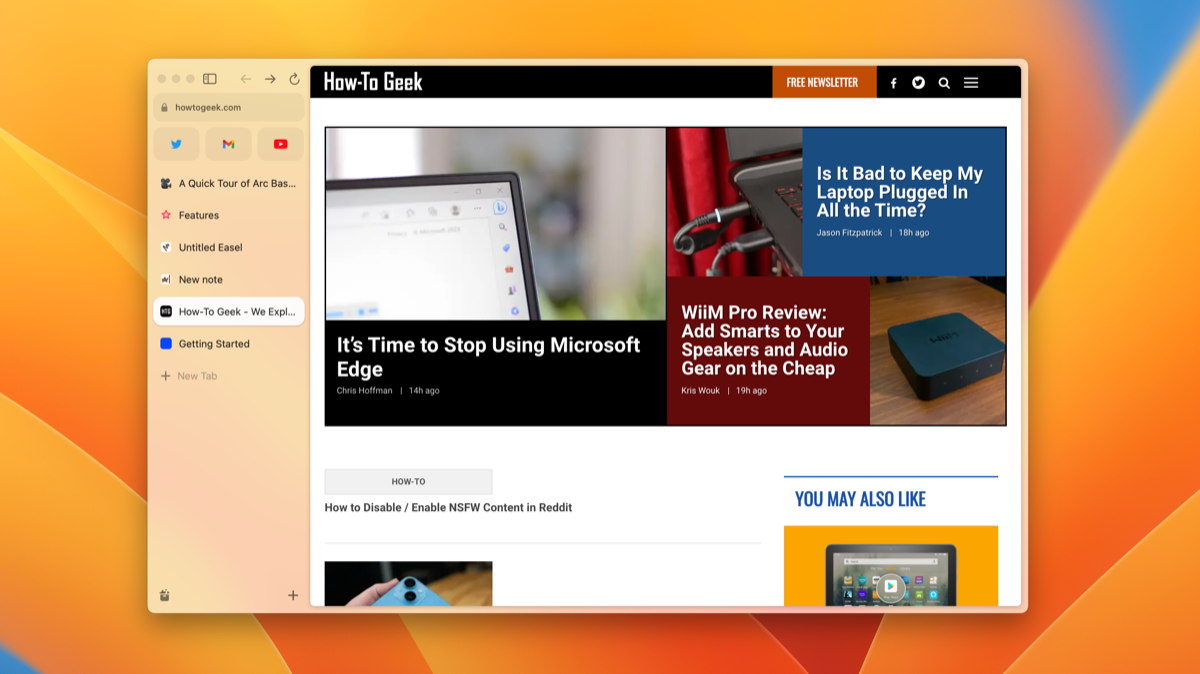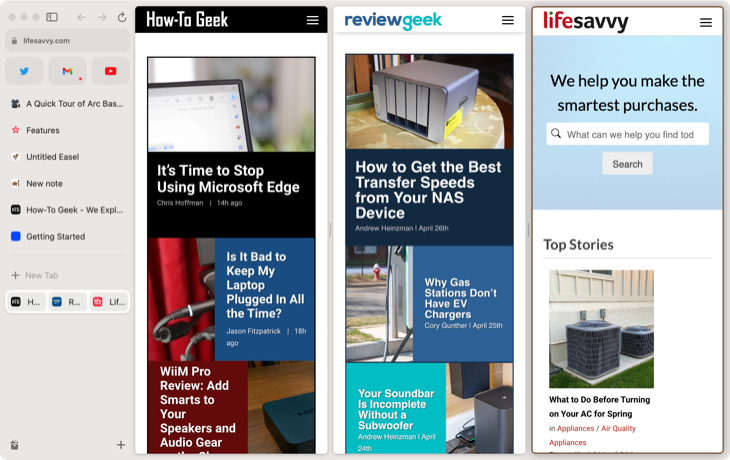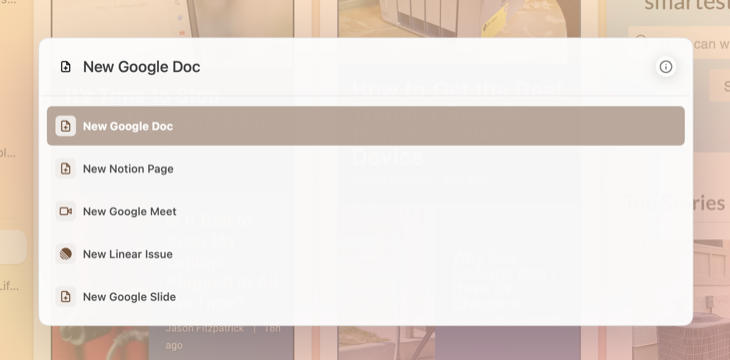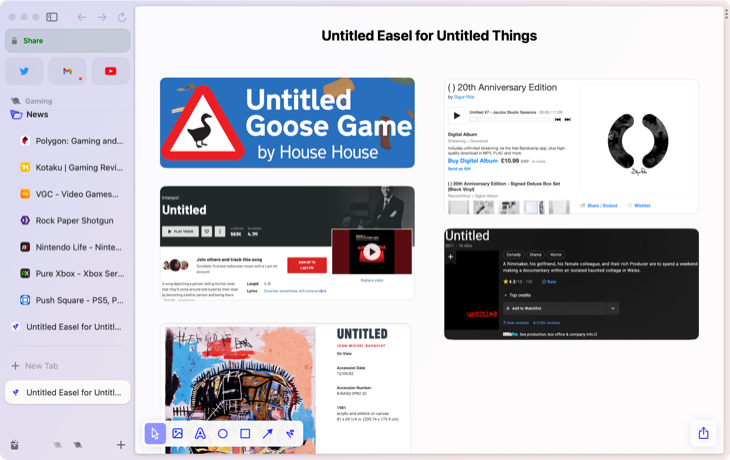Quick Links
Arc is a new browser that does things a little differently compared with browsers like Chrome, Edge, and Safari. Deep down it's a Chromium-based web browser, but the way you interact with the browser makes for a unique experience.
The Arc User Interface
The most obvious difference you'll notice when you first boot up Arc by The Browser Company is the user interface. The combined URL and search bar aren't at the top of the screen, nor are your tabs, bookmarks, and extensions. Instead, everything lives in the sidebar to the left of the screen. As a result, there's (currently) no space for extension buttons as there is on other browsers, which at least keeps the interface relatively tidy.
You can toggle this sidebar on and off for a full-screen browsing experience where the sidebar only appears when you mouse over the left edge of the screen. The UI is a bit different from what you're probably used to, but it works well with some of the other design decisions that the Arc team has made.
A feature called Split View functions much like the macOS feature of the same name, allowing you to view up to four tabs at once. These tabs appear grouped in the sidebar so you can keep them together. Doing this in other browsers requires that you split tabs into separate windows, which can make window management a bit messy.
Arc also makes use of color to flavor the user interface, depending on which set of tabs you are currently using.
Cutting Through the Tab Clutter
Do you find yourself collecting tabs to the point where you have everything open at once, just in case? Arc is a browser that wants to change this. By default, Arc closes new tabs after 12 hours unless you pin them. You can change the timing (up to 30 days) but you can't turn tab pruning off.
Proactive tab management is a cornerstone of the Arc experience, and we think it's for the better. When tabs are closed (or archived, as Arc puts it) you'll find them listed on a dedicated "Archived Tabs" section, sorted by the day they were eventually closed. It's not going to be to everyone's tastes, but it will make you more conscious about the way you use tabs.
Arc's penchant for tab management means you've got a dedicated area for your favorites and pinned tabs, and a separate area for "Today's tabs" at the bottom of the pile. It's quite refreshing opening Arc in the morning without having to deal with the clutter of yesterday's browsing session.
Do (Almost) Everything with the Command Bar
Perhaps Arc's smartest feature is the Command Bar, which fuses actionable commands directly into the combined URL and search bar. It's a bit like macOS Spotlight or apps like Alfred and Raycast. It allows you to do virtually everything simply by typing, without taking your hands off the keyboard.
Hit Command+L to access the current tab's Command Bar, or hit Command+T to open a new tab and jump right to it. From here, you can type a search query, web address, or action. Actions include things like "Pin Tab" to save the currently-active tab, "Add Split View" to pin the current tab to one side of the screen, and "Capture Full Page" to take a screenshot.
You can access extensions, view your list of archived tabs, see settings, switch to other tabs, edit your current theme, move to or start a new space, and just about anything else you can think of using this interface. Web services like Google Docs also work with the Command Bar. The only thing it doesn't do (so far) is offer a "tab to search" style experience as is so common in other browsers.
You can remedy this by switching the default search engine to DuckDuckGo and using bangs (like !htg) to search websites instead.
Separate Tabs Into Spaces and Separate Profiles
In a further bid to keep your tabs organized, Arc includes a feature called Spaces. The idea here is to keep tabs organized into separate areas which you can recall as you need them. You might have different spaces for personal, work, or school tabs. Different spaces are colored differently, allowing you to tell them apart at a glance.
You can move tabs between spaces using the Command Bar or by right-clicking on a tab and selecting the "Move to" option. Keep tabs pinned within relevant spaces rather than keeping everything pinned in a single space to prevent the interface from becoming too cluttered.
On top of this, different spaces can have different profiles. Profiles work a lot like they do on other browsers, where each profile has its own identity and data. The difference here is that profiles are applied to your spaces, which you can easily switch between on a whim.
So you can use different profiles for your home and work spaces, allowing you to log in to your Gmail account at home and at work without having to use account switching or have two profile windows open at once. It's not revolutionary, and browsers like Safari have similar systems, but Arc's system is one of the better ways we've seen it done.
More Than a Browser Out of the Box
Most web browsers are spartan affairs that allow you to expand functionality by way of extensions. Arc is different in that it includes a few nice-to-have extras out of the box. The upside of this is that they integrate with the browser's other features a little more tightly than your average third-party extension.
Easels let you create scrapbooks or mood boards. You can take a "magic" screenshot by clicking on the camera icon in the URL bar (or using the Command Bar), which links back to the website that was captured. You can add text, shapes, arrows, and your own drawings. These can be collaborated upon with other Arc users or published to the web so that they're viewable by anyone (like this one).
Arc also functions as a note-taking app, with Notes appearing as tabs alongside your standard tabs. Notes can be shared as read-only web pages online. You don't have to use either Easels or Notes but the features are there if you want them, they work well with features like Split View and the Command Bar, and you can organize them fairly neatly with folders and Spaces.
Arc has a mobile companion app for iOS which allows you to access your tabs, spaces, as well as features like Easels and Notes from an iPhone. There's currently no Android app, but it's likely something Arc's developers would be interested in adding at some stage.
Lastly, Arc also includes Boosts. These let you make changes to web pages you frequent, like changing elements of CSS in a stylesheet or adding your own custom code to change the way a page behaves. These changes persist until you delete the relevant boost.
These features can pretty much all be added to other browsers with the right combination of extensions. There are arguments to be made for picking more established whiteboard apps or keeping your note-taking separate from your browser, but for some tying these things into the app they use most of all is a compelling prospect.
What Arc Isn't
Arc does a lot of things, but there are a few things the web browser lacks. The most obvious thing (at the time of writing in May 2023) is a Windows version. Arc is only available for macOS and currently requires that you sign up for an invite to get access to the Arc homepage. The mobile app is far from a fully-fledged web browser, which explains why it's classed as a "Companion" app instead.
Arc also lacks many of the optimizations you might expect from your primary web browser. On a Mac, it won't beat Safari in terms of energy consumption, and it lacks the silky smooth scrolling of Apple's browser. Based on this, it will probably take a while for the eventual Windows version to compete with the efficiency of Edge for Windows users. On the upside, its Chromium back-end means that it feels snappy and performs well in most browser benchmarks.
Arc is about as private as Google Chrome when it comes to blocking trackers and tracking advertisers, which is to say it scores poorly. If privacy is your main concern, we'd recommend giving Firefox a go instead.
It's also not the best choice if you use a lot of extensions, since not all Chrome extensions work, and you lose out on having dedicated toolbar buttons (which can make it harder to access certain features).
Not all of these will be major issues for everyone, and many of them will be fixed over time. Arc has demonstrated a working Windows version of the browser, and performance is sure to improve over time as the browser is further refined.
While you ponder if Arc is right for you, take a look at some good arguments for ditching Google Chrome and why you should give Microsoft Edge the boot.







